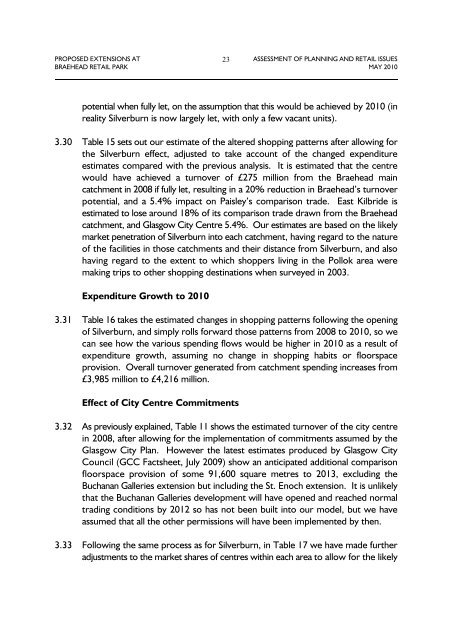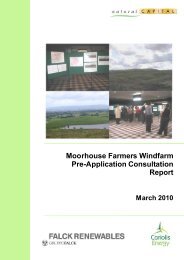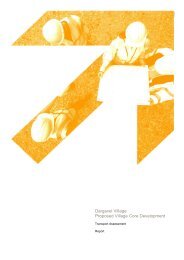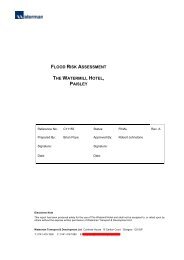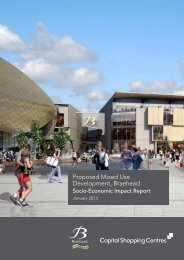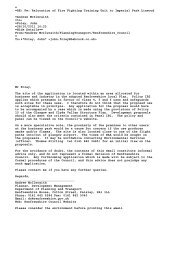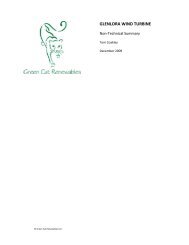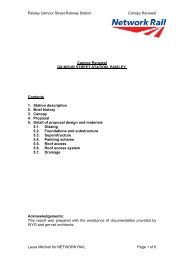Assessment of Planning and Retail Issues - Renfrewshire Council
Assessment of Planning and Retail Issues - Renfrewshire Council
Assessment of Planning and Retail Issues - Renfrewshire Council
Create successful ePaper yourself
Turn your PDF publications into a flip-book with our unique Google optimized e-Paper software.
PROPOSED EXTENSIONS AT 23 ASSESSMENT OF PLANNING AND RETAIL ISSUES<br />
BRAEHEAD RETAIL PARK MAY 2010<br />
potential when fully let, on the assumption that this would be achieved by 2010 (in<br />
reality Silverburn is now largely let, with only a few vacant units).<br />
3.30 Table 15 sets out our estimate <strong>of</strong> the altered shopping patterns after allowing for<br />
the Silverburn effect, adjusted to take account <strong>of</strong> the changed expenditure<br />
estimates compared with the previous analysis. It is estimated that the centre<br />
would have achieved a turnover <strong>of</strong> £275 million from the Braehead main<br />
catchment in 2008 if fully let, resulting in a 20% reduction in Braehead’s turnover<br />
potential, <strong>and</strong> a 5.4% impact on Paisley’s comparison trade. East Kilbride is<br />
estimated to lose around 18% <strong>of</strong> its comparison trade drawn from the Braehead<br />
catchment, <strong>and</strong> Glasgow City Centre 5.4%. Our estimates are based on the likely<br />
market penetration <strong>of</strong> Silverburn into each catchment, having regard to the nature<br />
<strong>of</strong> the facilities in those catchments <strong>and</strong> their distance from Silverburn, <strong>and</strong> also<br />
having regard to the extent to which shoppers living in the Pollok area were<br />
making trips to other shopping destinations when surveyed in 2003.<br />
Expenditure Growth to 2010<br />
3.31 Table 16 takes the estimated changes in shopping patterns following the opening<br />
<strong>of</strong> Silverburn, <strong>and</strong> simply rolls forward those patterns from 2008 to 2010, so we<br />
can see how the various spending flows would be higher in 2010 as a result <strong>of</strong><br />
expenditure growth, assuming no change in shopping habits or floorspace<br />
provision. Overall turnover generated from catchment spending increases from<br />
£3,985 million to £4,216 million.<br />
Effect <strong>of</strong> City Centre Commitments<br />
3.32 As previously explained, Table 11 shows the estimated turnover <strong>of</strong> the city centre<br />
in 2008, after allowing for the implementation <strong>of</strong> commitments assumed by the<br />
Glasgow City Plan. However the latest estimates produced by Glasgow City<br />
<strong>Council</strong> (GCC Factsheet, July 2009) show an anticipated additional comparison<br />
floorspace provision <strong>of</strong> some 91,600 square metres to 2013, excluding the<br />
Buchanan Galleries extension but including the St. Enoch extension. It is unlikely<br />
that the Buchanan Galleries development will have opened <strong>and</strong> reached normal<br />
trading conditions by 2012 so has not been built into our model, but we have<br />
assumed that all the other permissions will have been implemented by then.<br />
3.33 Following the same process as for Silverburn, in Table 17 we have made further<br />
adjustments to the market shares <strong>of</strong> centres within each area to allow for the likely


